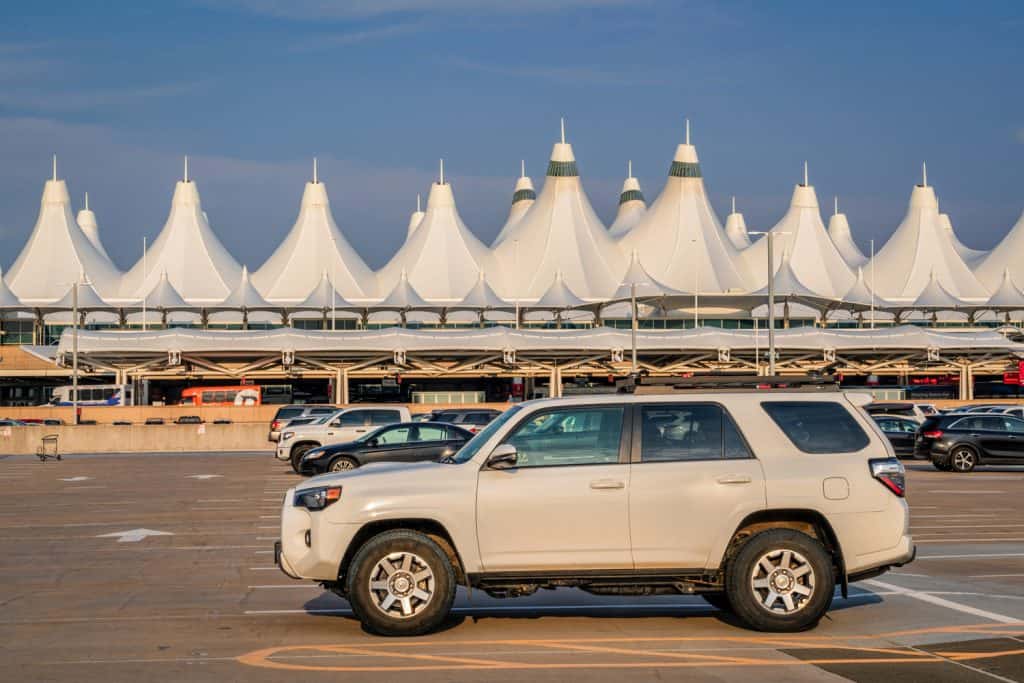Did you try to drive out of your garage and discover—to your horror—that your Toyota 4Runner wouldn’t shift into reverse? We researched this problem and have the solution for you.
Several situations could prevent you from shifting to reverse. Here are some of the issues that you could check:
- Pressure on the transmission parking lock.
- Problematic shift lock solenoid.
- Bad shift linkage.
- Dirty transmission fluid.
The situations above apply only to a Toyota 4Runner with an automatic transmission. We have a different set of situations for a Toyota 4Runner that has a manual transmission in the sections below. Additionally, we will talk about the four issues above in greater detail and what you should do in the succeeding sections.

Toyota 4Runner won’t go in reverse—what could be wrong?

A problem with changing gears is commonly associated with the transmission. However, with the advances in automatic transmission technology, there are systems in place that can prevent shifting.
1. Pressure on the transmission parking lock
If you parked on an inclined area like a hill, the force of gravity can cause your transmission to lock the park gear in place to help keep your Toyota 4Runner in place. This happens a lot whenever the Toyota 4Runner is parked in an inclined position, and the parking brake is not used to secure it.
Getting it unstuck is easy but tricky at the same time. Follow these simple steps to get your Toyota 4Runner unstuck:
- Sit on the driver’s seat and get ready to step on the brakes immediately when needed.
- Rock your Toyota 4Runner by throwing your weight around.
- Step on the brakes right away when you start to feel that your Toyota 4Runner is slipping down.
Catching your Toyota 4Runner with the brakes as it starts to slip will release the pressure on the parking lock mechanism of the transmission. You can shift to reverse once the parking lock has been released.
Make it a habit to engage the parking brakes (manufacturers stopped calling it emergency brakes for this reason) whenever you’re getting out of your Toyota 4Runner to avoid this situation from happening again.
2. Problematic shift lock solenoid
Vehicles with automatic transmission have a mechanism that prevents you from shifting out of park if your foot is not on the brake pedal. What controls this mechanism is the shift lock solenoid.
Unfortunately, the shift lock solenoid sometimes malfunctions and will not let the shifter out of the park position. The good news is that there is an override button that will allow you to unlock the shifter so that you can get to the reverse position of your transmission.
Here are the steps to release the shift lock:
- Look for a covered hole near the shifter that looks like a slightly bigger port for a lightning cable or a USB-C. Some Toyota 4Runner models have this override button located somewhere else. You’d have to consult your manual if it is not near the shifter.
- Use a small screwdriver to pry the cover open. You will also need the screwdriver to press the button at the bottom of the hole.
- Once you’ve got it open, press the button with a screwdriver and hold it, then shift from park to reverse. This should allow you to drive out of your garage or from wherever you parked your Toyota 4Runner.
- Have a mechanic check your shift lock solenoid (and determine whether it needs to be replaced) to avoid this problem from happening again.
3. Bad shift linkage
Shift linkages normally last the entire lifetime of your Toyota 4Runner. However, if the first two solutions above did not fix the problem, then the likely issue is a bad shift linkage.
A bad shift linkage could be caused by loose or worn-out bushing. If it is a worn-out bushing, then the size and shape of the linkage may no longer be right for the connection. This, in turn, would cause it to become even looser.
Unfortunately, with the many different parts that can come loose in the shift linkage of your Toyota 4Runner, the fastest way to resolve this is to get a mechanic to verify and fix the issue for you.
4. Dirty automatic transmission fluid
Transmission fluid is responsible for maintaining the parts of the transmission system by providing lubrication, maintaining fluid pressure, cooling, and preventing oxidation. Moreover, the transmission fluid provides the necessary hydraulic pressure and friction that allow the proper functioning of the transmission system.
The torque converter inside the automatic transmission works under the principles of fluid dynamics.
Unfortunately, the ATF (automatic transmission fluid) accumulates dirt, debris, and other particles through usage. If the concentration of these foreign materials gets higher, they can interfere with the operation of the transmission and prevent you from shifting to reverse.
To remedy this, flushing out your transmission fluid and replacing it with a fresh batch is necessary. Follow your Toyota 4Runner’s maintenance schedule for replacing the automatic transmission fluid to prevent this issue.
Check out the 4-pack Toyota Automatic Transmission Fluid through this link.
Toyota 4Runner Manual Transmission Won't Reverse
The scenarios that we outlined in earlier sections apply only to Toyota 4Runner with an automatic transmission. We discuss the scenarios that apply to a Toyota 4Runner with a manual transmission in the succeeding sections.

Loose shift linkage or damaged shift cables
A shift cable that has been stretched too much can make your shift stick point to reverse, but your gears will remain in neutral. This will prevent the shifter from moving far enough to lock into the gears that will allow your Toyota 4Runner to move in reverse.
The same situation will happen if the points where these cables or linkages are connected become loose. Loose linkages can be adjusted by a mechanic. However, damaged shift cables will have to be replaced.
Possible clutch problem
In a Toyota 4Runner with a manual transmission, the clutch is responsible for the connection between the shaft coming from the engine and the shaft that provides power to the wheels. This system allows drivers to disconnect the wheels from the engine so that they can shift to a different gear, giving them a great deal of control over the speed and power output of their vehicle.
If there is a problem with the clutch, it will be difficult or problematic to shift to reverse.
- Switch on your engine.
- Step on the clutch pedal a few times to pump it. Shift into reverse while trying to release the clutch pedal and observe if the transmission is getting engaged or not.
- Turn off your engine if the transmission is not engaging. Step on the clutch pedal and then switch to first gear. Switch to neutral from first gear.
- Try to shift to reverse from neutral. If you’re able to shift to reverse while the engine is off, then the problem is likely with your clutch and not the transmission.
Worn out clutch disc
A worn-out clutch disk can cause the transmission to slip. This causes your Toyota 4Runner to seem to be in reverse (or in another gear) but doesn’t receive power from the engine. The clutch disk naturally gets worn out in manual transmission vehicles and needs regular replacement.
Bring your Toyota 4Runner to an experienced mechanic to replace your clutch disc if you’re experiencing this issue.
Problematic synchronizers
A synchronizer or synchros assists the gears (while they are running rapidly) to smoothly mesh together in a manual transmission. If you do a lot of heavy-footed driving and you’re aggressive when shifting, the synchros will wear out faster.
When you feel or hear grinding whenever you shift into a gear, that is a sign that the synchronizers are starting to get worn out. Another symptom is when your Toyota 4Runner suddenly pops out of gear and returns to neutral without you doing anything.
Unfortunately, this is one of the problems that you will encounter with your Toyota 4Runner that is best resolved by a mechanic.
Troubleshooting for Automatic or Manual Transmissions

The scenarios below were placed in their own group because they can apply to a Toyota 4Runner with an automatic or manual transmission.
Worn out seals and gaskets
Check the seals and gaskets of your Toyota 4Runner. The seals and gaskets keep the transmission fluid inside your Toyota 4Runner.
If there is a leak, you’d slowly lose transmission fluid. And if the level of the transmission fluid is low, you will not be able to shift to reverse. According to Toyota of Manchester, you will not be able to shift to reverse if the transmission fluid is not enough or if the wrong type was used on your Toyota 4Runner.
If you are not sure where to check for the seals and gaskets of your Toyota 4Runner’s transmission, have a mechanic do it for you.
ECM going bad
The ECM or Engine Control Module is a type of computer that controls several actuators based on data that it gets from the many sensors inside your Toyota 4Runner. It interprets these data through performance mapping, then it makes applicable adjustments based on its interpretations.
If the ECM in your Toyota 4Runner gets damaged, it will not be able to properly monitor your 4Runner and make the necessary adjustments. A bad ECM will eventually lead to more serious problems than not being able to shift to reverse.
Unfortunately, the only way to fix this would be through a trained mechanic.
Conclusion

A problem with shifting is often attributed immediately to the transmission. However, interconnected systems can create problems that look like an issue with the transmission when it might not be.
If you enjoyed this article, you’d likely find these other articles interesting:

